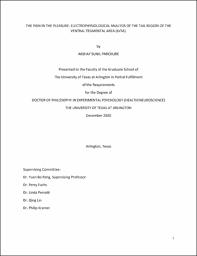
ATTENTION: The works hosted here are being migrated to a new repository that will consolidate resources, improve discoverability, and better show UTA's research impact on the global community. We will update authors as the migration progresses. Please see MavMatrix for more information.
Show simple item record
| dc.contributor.advisor | Peng, Yuan Bo | |
| dc.creator | Parchure, Akshay | |
| dc.date.accessioned | 2020-12-22T20:18:11Z | |
| dc.date.available | 2020-12-22T20:18:11Z | |
| dc.date.created | 2020-12 | |
| dc.date.issued | 2020-12-07 | |
| dc.date.submitted | December 2020 | |
| dc.identifier.uri | http://hdl.handle.net/10106/29636 | |
| dc.description.abstract | The mesolimbic (midbrain) reward system is well documented to be involved with the analgesic effects of opioids, which involves the ventral tegmental area (VTA) causing release of dopamine (DA). The dopamine neurons from the ventral tegmental area (VTA) directly innervate the nucleus accumbens (NAc) and the prefrontal cortex via D1 DA Receptors. GABAergic inhibition of VTA DA system occurs regularly, but in 1990s Johnson and North showed the administration of opioids led to hyperpolarization of GABA interneurons in the VTA removing this inhibition, further leading to the “disinhibition model”. However, more recent studies have defined a new structure heavily influencing this DA system i.e. the tail of the ventral tegmental area (tVTA). The tVTA sends dense GABA projections to VTA. tVTA neurological connections have been postulated to play an influential part not only in the mesocorticolimbic pathway but also in the nigrostriatal pathway Research has also shown that neurons from the tVTA overwhelmingly synapse on the tyrosine hydroxylase positive neurons within the VTA as well as the substantia nigra and electrically stimulation of the tVTA suppresses the DA neuron firing. Previous studies have proposed that tVTA may play an important role conveying information about noxious stimuli to the VTA DA neurons and mediate the appropriate response. There are however some fundamental questions still unanswered and unaddressed. Previous studies have indicated that these inhibitory responses are driven by the GABAergic transmission onto the DA neurons, hence it’s important to observe opioid-induced alterations of local field potentials (LFPs), especially post noxious stimuli (formalin) and the involvement of dopamine (DA) system in this process recorded simultaneously from the four brain regions, tVTA, VTA, NAc and ACC. Here, I present data demonstrating that administering formalin significantly increased the LFP activity in the tVTA., An increase in activity within the VTA and ACC was also observed following formalin injection with all the waves exhibiting increased activity expect the gamma. Morphine injections led to significant increase in activity in the NAc, however very low to no activity was observed within this region following a noxious stimulus. Thus, it could very well be postulated that tVTA-VTA-NAc-ACC complex neurocircuitry could very well play any important role in relaying nociceptive information. | |
| dc.format.mimetype | application/pdf | |
| dc.language.iso | en_US | |
| dc.subject | tVTA | |
| dc.subject | Pain | |
| dc.subject | Nociception | |
| dc.subject | Morphine | |
| dc.title | THE PAIN IN THE PLEASURE: ELECTROPHYSIOLOGICAL ANALYSIS OF THE TAIL REGION OF THE VENTRAL TEGMENTAL AREA (tVTA) | |
| dc.type | Thesis | |
| dc.degree.department | Psychology | |
| dc.degree.name | Doctor of Philosophy in Psychology | |
| dc.date.updated | 2020-12-22T20:18:12Z | |
| thesis.degree.department | Psychology | |
| thesis.degree.grantor | The University of Texas at Arlington | |
| thesis.degree.level | Doctoral | |
| thesis.degree.name | Doctor of Philosophy in Psychology | |
| dc.type.material | text | |
Files in this item
- Name:
- PARCHURE-DISSERTATION-2020.pdf
- Size:
- 2.144Mb
- Format:
- PDF
This item appears in the following Collection(s)
Show simple item record


